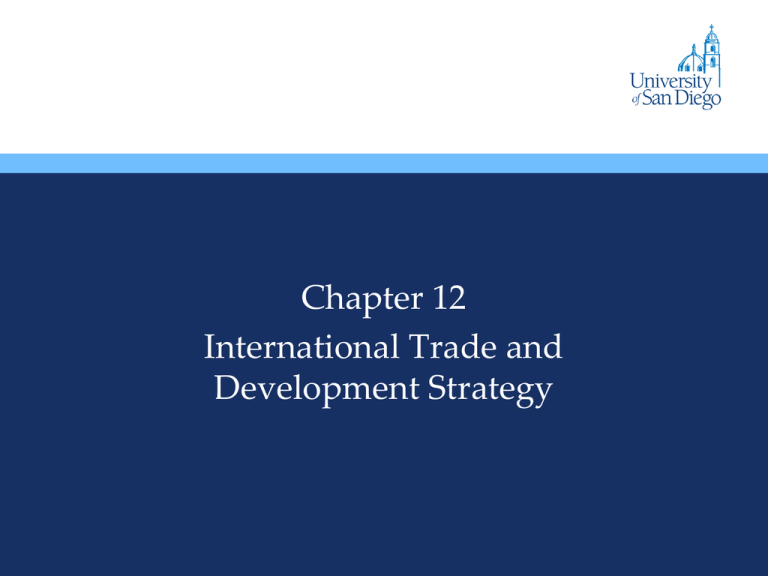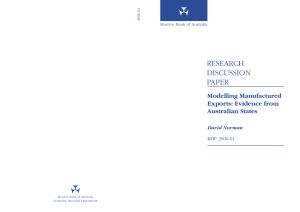Chapter 12 - University of San Diego Home Pages
advertisement

Chapter 12 International Trade and Development Strategy Basic Questions 1. How does trade affect rate, structure and character of LDC economic growth? 2. Does trade serve as an engine of growth? 3. How does trade affect income distribution? 4. Should LDC’s adopt outward-looking trade policy? Importance of Exports Y = C + I + G + (E-M) High levels of exports (relative to imports) have generated high levels of growth in Japan, South Korea, former Hong Kong and China. Strategic export policy can provide a ‘big push’ to the economy and lead the country out of the poverty cycle. Importance of Exports Country Exports as % of GDP % share of primary products Philippines 42 25 China 34 8 Indonesia 30 53 South Korea 36 9 India 12 30 15.5 10 Japan 13 8 US 7 18 Bangladesh Role of Primary Products Examples – Foodstuffs, rubber, vegetable oil, cotton, leather, jute 1. Income elasticity is low when income rises in developed countries, demand for primary goods increases slowly. Foodstuffs 0.6% agricultural raw materials 0.5%. On the other hand, demand for manufactured goods – 1.9% 2. Relative Price of primary goods declines in the long-run 3. Price elasticity is also very low 4. Supply of primary products is also inelastic 5. It causes instability of export earnings and volatile price fluctuations. Prebisch – Singer Thesis Px •Commodity terms of trade P is defined as the m ratio of export price to import price •According to Prebisch – Singer Thesis, there is a secular (long-term) deterioration in commodity terms of trade for primary goods. This is due to low price and income elasticities •Need for diversification to manufactured goods. Trade Strategies – Export Promotion vs Import substitution • Outward-looking or export promotion policies followed by Japan, South Korea, Taiwan, Singapore, Hong Kong and China - Emphasis on Free-Trade, less trade barriers, Free movement of foreign capital - Strategic policies of exports - Export zones & export promotion • Export promotion policies for primary as well as manufactured goods Problems of Export Promotion Policy (1) Expanding primary goods – demand side • Low income elasticity • Low price elasticity • Low population growth rates in developed countries • Commodity agreements not very successful • Development of synthetic substitutes • Protective policies against food exports, agricultural products – sugar quota, subsidies Export Promotion (2) supply side • Structural rigidities in rural production system – soil, climate, rural institutions, land tenure • Local shortages due to exports • Farmers – risk averse • Fragmented land holdings. Together, these problems could have an adverse effect on export earnings of LDCs Export Promotion – manufactured goods • In South Korea, Taiwan, export growth was led by manufactured goods (20% or more) • China’s share in manufactured goods exports is increasing • In developing countries share of manufactured goods: 1950 – 6% , 2000 – 64% Export Promotion – manufactured goods Demand side issues • Widespread protection against LDC’s exports of manufactured goods Assignment – Find supportive statements from page 622-623. Write a paragraph on how DC can help by imposing less barriers – What are the likely consequences for DC and LDCs Import - Substitution • Substitute domestic goods for imported goods, selfsufficiency • Impose tariffs or quotas on imports • Provide infant industry protection • Government subsidies and intervention • Improve balance of payments • Achieve large scale and lower prices • Reap the benefits of comparative advantages Import Substitution - Disadvantages • Protective policies discourage competition and efficiency – Is industry remain high cost and inefficient industry? • Foreign firms benefit due to tariff walls • Imports of capital intermediate good are costly • Overvalued, artificial exchange rates which raises the price of exports and reduces the price of imports. Overvalued currency helps local manufactures to increase their exports and imports cheap capital goods • Problems of infant industry Tariff Structures and Effective Protection Self-study Nominal rate of protection = P' P t P Effective rate of protection = V ' V g V •Fixed Exchange rate system Exchange rates are officially fixed. If there is a huge balance of payments deficit, currency will be devalued. •Floating exchange rate system Exchange rates are determined by demand and supply. Depreciation implies a decrease in the purchasing power of domestic currency Prices of foreign exchange (units of domestic currency per unit of foreign currency) Foreign Exchange Market S Pb Pe Pa D M’ M M’’ Quantity of foreign exchange Foreign Exchange Market • Managed Float – Exchange rates fluctuate within a certain range • Asian Crisis of 1997 South Korea, Thailand, Malaysia, Indonesia adopted floating exchange rate system. Currencies lost 30% of their value and IMP bailed out some of these countries.







